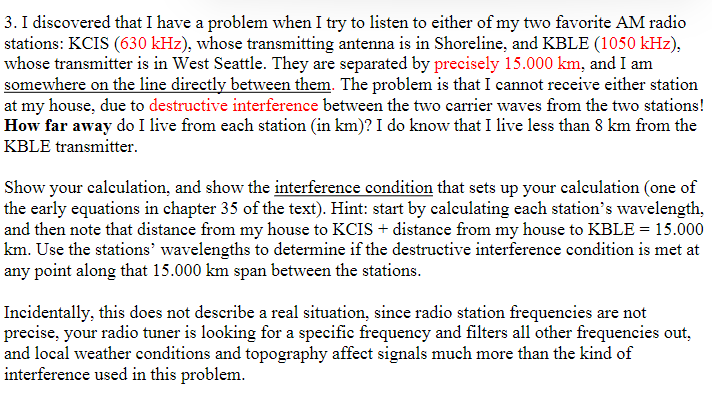3. I discovered that I have a problem when I try to listen to either of my two favorite AM radio stations: KCIS (630 kHz), whose transmitting antenna is in Shoreline, and KBLE (1050 kHz), whose transmitter is in West Seattle. They are separated by precisely 15.000 km, and I am somewhere on the line directly between them. The problem is that I cannot receive either station at my house, due to destructive interference between the two carrier waves from the two stations! How far away do I live from each station (in km)? I do know that I live less than 8 km from the KBLE transmitter. Show your calculation, and show the interference condition that sets up your calculation (one of the early equations in chapter 35 of the text). Hint: start by calculating each station's wavelength, and then note that distance from my house to KCIS + distance from my house to KBLE = 15.000 km. Use the stations' wavelengths to determine if the destructive interference condition is met at any point along that 15.000 km span between the stations. Incidentally, this does not describe a real situation, since radio station frequencies are not precise, your radio tuner is looking for a specific frequency and filters all other frequencies out, and local weather conditions and topography affect signals much more than the kind of interference used in this problem.
3. I discovered that I have a problem when I try to listen to either of my two favorite AM radio stations: KCIS (630 kHz), whose transmitting antenna is in Shoreline, and KBLE (1050 kHz), whose transmitter is in West Seattle. They are separated by precisely 15.000 km, and I am somewhere on the line directly between them. The problem is that I cannot receive either station at my house, due to destructive interference between the two carrier waves from the two stations! How far away do I live from each station (in km)? I do know that I live less than 8 km from the KBLE transmitter. Show your calculation, and show the interference condition that sets up your calculation (one of the early equations in chapter 35 of the text). Hint: start by calculating each station's wavelength, and then note that distance from my house to KCIS + distance from my house to KBLE = 15.000 km. Use the stations' wavelengths to determine if the destructive interference condition is met at any point along that 15.000 km span between the stations. Incidentally, this does not describe a real situation, since radio station frequencies are not precise, your radio tuner is looking for a specific frequency and filters all other frequencies out, and local weather conditions and topography affect signals much more than the kind of interference used in this problem.
Introductory Circuit Analysis (13th Edition)
13th Edition
ISBN:9780133923605
Author:Robert L. Boylestad
Publisher:Robert L. Boylestad
Chapter1: Introduction
Section: Chapter Questions
Problem 1P: Visit your local library (at school or home) and describe the extent to which it provides literature...
Related questions
Question

Transcribed Image Text:3. I discovered that I have a problem when I try to listen to either of my two favorite AM radio
stations: KCIS (630 kHz), whose transmitting antenna is in Shoreline, and KBLE (1050 kHz),
whose transmitter is in West Seattle. They are separated by precisely 15.000 km, and I am
somewhere on the line directly between them. The problem is that I cannot receive either station
at my house, due to destructive interference between the two carrier waves from the two stations!
How far away do I live from each station (in km)? I do know that I live less than 8 km from the
KBLE transmitter.
Show your calculation, and show the interference condition that sets up your calculation (one of
the early equations in chapter 35 of the text). Hint: start by calculating each station's wavelength,
and then note that distance from my house to KCIS+ distance from my house to KBLE = 15.000
km. Use the stations' wavelengths to determine if the destructive interference condition is met at
any point along that 15.000 km span between the stations.
Incidentally, this does not describe a real situation, since radio station frequencies are not
precise, your radio tuner is looking for a specific frequency and filters all other frequencies out,
and local weather conditions and topography affect signals much more than the kind of
interference used in this problem.
Expert Solution
This question has been solved!
Explore an expertly crafted, step-by-step solution for a thorough understanding of key concepts.
This is a popular solution!
Trending now
This is a popular solution!
Step by step
Solved in 3 steps

Knowledge Booster
Learn more about
Need a deep-dive on the concept behind this application? Look no further. Learn more about this topic, electrical-engineering and related others by exploring similar questions and additional content below.Recommended textbooks for you

Introductory Circuit Analysis (13th Edition)
Electrical Engineering
ISBN:
9780133923605
Author:
Robert L. Boylestad
Publisher:
PEARSON

Delmar's Standard Textbook Of Electricity
Electrical Engineering
ISBN:
9781337900348
Author:
Stephen L. Herman
Publisher:
Cengage Learning

Programmable Logic Controllers
Electrical Engineering
ISBN:
9780073373843
Author:
Frank D. Petruzella
Publisher:
McGraw-Hill Education

Introductory Circuit Analysis (13th Edition)
Electrical Engineering
ISBN:
9780133923605
Author:
Robert L. Boylestad
Publisher:
PEARSON

Delmar's Standard Textbook Of Electricity
Electrical Engineering
ISBN:
9781337900348
Author:
Stephen L. Herman
Publisher:
Cengage Learning

Programmable Logic Controllers
Electrical Engineering
ISBN:
9780073373843
Author:
Frank D. Petruzella
Publisher:
McGraw-Hill Education

Fundamentals of Electric Circuits
Electrical Engineering
ISBN:
9780078028229
Author:
Charles K Alexander, Matthew Sadiku
Publisher:
McGraw-Hill Education

Electric Circuits. (11th Edition)
Electrical Engineering
ISBN:
9780134746968
Author:
James W. Nilsson, Susan Riedel
Publisher:
PEARSON

Engineering Electromagnetics
Electrical Engineering
ISBN:
9780078028151
Author:
Hayt, William H. (william Hart), Jr, BUCK, John A.
Publisher:
Mcgraw-hill Education,